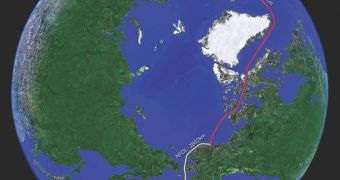It appears that the current speed of the Internet is not looked upon with kind eyes by Japan and the United kingdom, so the two countries have decided to do something about it.
Currently, it takes about 230 milliseconds for a data packet to get from London to Tokyo, a speed owed mostly to the roundabout manner in which the physical web cables reach from one place to the other.
The signal has to cross Europe, the Middle East and the Indian Ocean, or the Atlantic, US, and Pacific.
It has been decided that three fiber optics cables will be added to the existing network, all of which will follow a more direct route.
Two of the cables, the Arctic Fibre and Arctic Link, will cross the Northwest Passage that runs through the Canadian Arctic Archipelago.
The third cable will go along the coast of Scandinavia and Russia and bears the name of Russian Optical Trans-Arctic Submarine Cable System (ROTACS).
In addition to speed, the cables will add “redundancy”, which means that having one physical network collapsing will not totally cut off one place form another.
At the present time, almost all cables that land in Asia go through a choke point in the Middle East or Luzon Strait between the Philippine and South China seas.
The only reason billions of people haven't woken up to an Internet-less world yet is because ships have been careful not to drop their anchors on that particular section of the seabed.
The Bering Sea, through which the new cables will land in the north of Japan, is more or less untraveled.
Nevertheless, there is still the danger of icebergs, so the wires will have to be sunk hundreds of meters below the water surface, at the very least.
At any rate, once the cables are in place, the latency will be reduced by around 30%, which means 170 ms or so (60ms less).
Participants in the stock market will be glad to know that they can more reliably trade stocks, since differences of milliseconds sometime determine a gain or loss of millions of dollars. Telemedicine will also benefit, as will telemarketing, teleconferencing and education in general.
The price of each cable will be of $600 million / 452 million Euro to $1.5 billion / 1.13 billion Euro. A cable ship will lay the wires in the ocean, after an ice breaker ship cuts a path for it of course.

 14 DAY TRIAL //
14 DAY TRIAL //